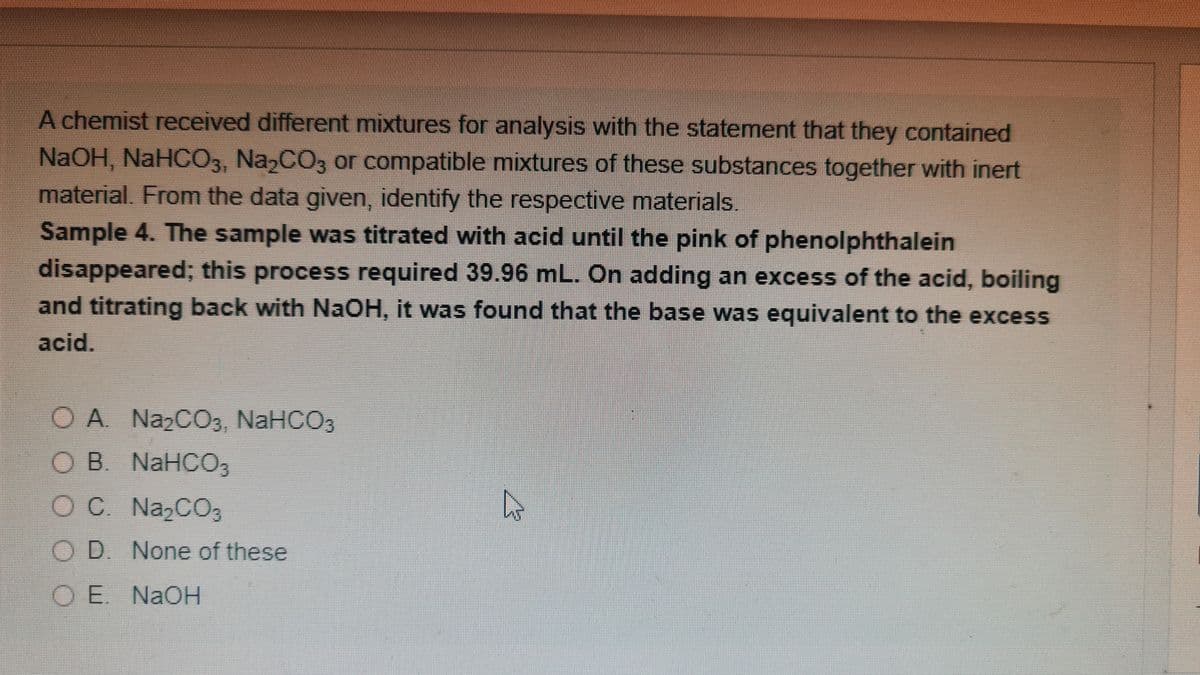A chemist received different mixtures for analysis with the statement that they contained NaOH, NaHCO3, Na2CO3 or compatible mixtures of these substances together with inert material. From the data given, identify the respective materials. Sample 4. The sample was titrated with acid until the pink of phenolphthalein disappeared; this process required 39.96 mL. On adding an excess of the acid, boiling and titrating back with NaOH, it was found that the base was equivalent to the excess acid. A. NazCO3, NaHCO3 В. NaHCOз O C. Na2CO3 O D. None of these OE. NAOH
A chemist received different mixtures for analysis with the statement that they contained NaOH, NaHCO3, Na2CO3 or compatible mixtures of these substances together with inert material. From the data given, identify the respective materials. Sample 4. The sample was titrated with acid until the pink of phenolphthalein disappeared; this process required 39.96 mL. On adding an excess of the acid, boiling and titrating back with NaOH, it was found that the base was equivalent to the excess acid. A. NazCO3, NaHCO3 В. NaHCOз O C. Na2CO3 O D. None of these OE. NAOH
Chemistry
10th Edition
ISBN:9781305957404
Author:Steven S. Zumdahl, Susan A. Zumdahl, Donald J. DeCoste
Publisher:Steven S. Zumdahl, Susan A. Zumdahl, Donald J. DeCoste
Chapter1: Chemical Foundations
Section: Chapter Questions
Problem 1RQ: Define and explain the differences between the following terms. a. law and theory b. theory and...
Related questions
Question

Transcribed Image Text:A chemist received different mixtures for analysis with the statement that they contained
NAOH, NaHCO3, Na,CO3 or compatible mixtures of these substances together with inert
material. From the data given, identify the respective materials.
Sample 4. The sample was titrated with acid until the pink of phenolphthalein
disappeared; this process required 39.96 mL. On adding an excess of the acid, boiling
and titrating back with NAOH, it was found that the base was equivalent to the excess
acid.
O A NazCO3, NaHCO3
OB. NaHCO3
O C. Na2CO3
O D. None of these
O E. NaOH
Expert Solution
This question has been solved!
Explore an expertly crafted, step-by-step solution for a thorough understanding of key concepts.
Step by step
Solved in 2 steps with 2 images

Knowledge Booster
Learn more about
Need a deep-dive on the concept behind this application? Look no further. Learn more about this topic, chemistry and related others by exploring similar questions and additional content below.Recommended textbooks for you

Chemistry
Chemistry
ISBN:
9781305957404
Author:
Steven S. Zumdahl, Susan A. Zumdahl, Donald J. DeCoste
Publisher:
Cengage Learning

Chemistry
Chemistry
ISBN:
9781259911156
Author:
Raymond Chang Dr., Jason Overby Professor
Publisher:
McGraw-Hill Education

Principles of Instrumental Analysis
Chemistry
ISBN:
9781305577213
Author:
Douglas A. Skoog, F. James Holler, Stanley R. Crouch
Publisher:
Cengage Learning

Chemistry
Chemistry
ISBN:
9781305957404
Author:
Steven S. Zumdahl, Susan A. Zumdahl, Donald J. DeCoste
Publisher:
Cengage Learning

Chemistry
Chemistry
ISBN:
9781259911156
Author:
Raymond Chang Dr., Jason Overby Professor
Publisher:
McGraw-Hill Education

Principles of Instrumental Analysis
Chemistry
ISBN:
9781305577213
Author:
Douglas A. Skoog, F. James Holler, Stanley R. Crouch
Publisher:
Cengage Learning

Organic Chemistry
Chemistry
ISBN:
9780078021558
Author:
Janice Gorzynski Smith Dr.
Publisher:
McGraw-Hill Education

Chemistry: Principles and Reactions
Chemistry
ISBN:
9781305079373
Author:
William L. Masterton, Cecile N. Hurley
Publisher:
Cengage Learning

Elementary Principles of Chemical Processes, Bind…
Chemistry
ISBN:
9781118431221
Author:
Richard M. Felder, Ronald W. Rousseau, Lisa G. Bullard
Publisher:
WILEY